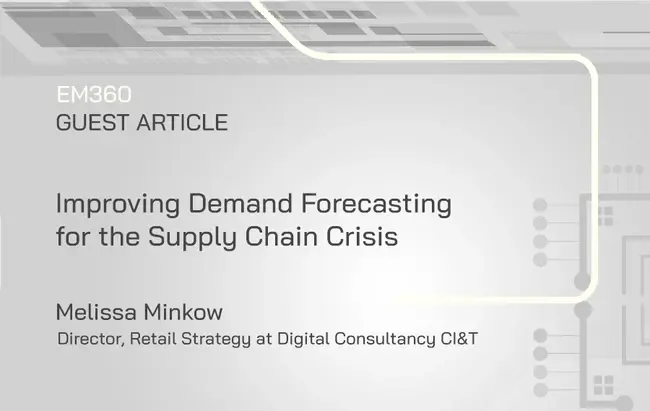
This article was written by Melissa Minkow, Director, Retail Strategy at Digital Consultancy at CI&T.
The COVID-19 pandemic has highlighted how complicated the global supply chain system is as retailers witness every component of their supply chain facing intense disruptions. Many of us thought days like the great 2020 toilet paper shortage were long behind us, however, the supply chain crisis seems to be growing into a much larger problem than any of us could have imagined. Recent news reports state that even primary schools in the UK are seeing a shortage of school dinners driven by the supply chain crisis, which continues to hit delivery demand.
Suez Canal blockage, shipping ports shut, factory shut-downs. Things continue to look bleak in the run up to the holiday season as retailers report delays in receiving consumer goods, with some even ringing the alarm on food shortages at Christmas. Supermarket retailers such as Morrisons and Co-Op have been warning that they will have to resort to hiking prices of stock as the supply chain and stock shortage is putting pressure on profits. The economic effects of the ‘pingdemic’, and compounding impact of Brexit, pose additional disruptions to an already difficult year for the retail sector.
Could these stock shortages be prevented? Underscored by the pandemic, unpredictability in demand has shone a huge light on just how poorly aligned retailers and suppliers are with each other. But by greater sharing of data and objectives, all of this can change. If retailers and suppliers establish more collaborative and aligned partnerships by co-owning data and aligning objectives, many stock-outs could be prevented.
Barriers to effective demand forecasting
The retailer-supplier relationship isn’t arranged in the way most conducive to confident demand forecasting. Though many variables contributed to the great shortage of toilet paper – alongside water, rice, pasta, and other essentials, supply issues are worsened by the misalignment of demand data strategies between suppliers and buyers. Demand forecasting is a team effort, and holistic execution is not possible if the parties involved aren’t working from the same data set. Currently, many suppliers purchase their data from third party vendors, which poses a challenge since they can’t always buy complete data sets that include other suppliers’ and retailers’ competitor sales.
Additionally, a nagging hesitancy to share sensitive data looms over the parties making it a struggle for them to work together. The lack of transparency is partly responsible for the divergent approaches to interpreting the data. In a time where there are already many disruptions and the COVID-19 pandemic is further threatening the stability of consumer-product supply chains, it’s imperative now more than ever that suppliers and retailers view key data through a single lens – something they are currently falling short on.
Discrepancy can also be found in the way suppliers and retailers make their predictions. Suppliers look at data from the same month year over year, contrastingly to retailers who reference the previous month's sales to predict the following month. And although comparing the same month year over year allows suppliers to account for seasonality, multiple assumptions are inherent in prioritising year over year data as it doesn’t account for variables like weather changes. For example, the assumption that March weather this year will be the same as March next year has been proven incorrect in the face of climate change. These two methods can yield vastly different conclusions about how much product to make, store and shelve for the next 30 days.
If 2020 taught us anything, it’s that one year’s sales could appear as the exact inverse from the past year’s. A lot can change in the space of 12 months - it’s too much time to assume enough consistency for forecasting demand, so perhaps retailers' shorter term methodology is more sensible.
Despite awareness of this reality, it has been found among retailers that a sense of scepticism arises when sales data is presented in real time and is too current. This is due to concerns around reliability of the forecast because it's deemed ‘too early to be consistently valid’.
The data points that should matter
Typically, the importance of consumer demographic data in predicting demand is something we hear of often, however, there are significant opportunities to find greater value in basket-level data. Being able to map out correlations between baskets (purchased items) will offer consistent predictive value over data such as a customer’s age or gender, which is data that all parties agree to be most valuable to them.
Consumer level data is reportedly the most desirable, but only focusing on sales and consumer data means that retailers and suppliers are missing out on centering pivotal purchase information that would benefit both forecasting and marketing agendas.
Consumers are relatively routine when it comes to grocery shopping, so knowing how much they typically spend, and how often, will be highly reliable data for forecasting future demand. Farmstead, a start-up grocery delivery service in the US, is already taking advantage of this, offering returning customers a five percent discount for repeated purchases. Rewarding returning customers for common behaviour - buying the same grocery item each shop - ultimately incentivises more predictable demand. While this does not track for other purchases which can be much more trend-driven in nature, companies can also collect data on the accompanying items within the basket to gather more insights. This can help to illuminate opportunities for both upselling and cross-selling among other brands.
A modern solution
Smart retailers will take interest in a data sharing relationship with suppliers. Allowing retailers to determine what type of data each supplier should have access to in an ‘uber-forecasting’ system is the way forward. Ensuring that relevant data is accessible and shared allows retailers and suppliers to align goals and optimise decision-making.
Both parties have much to gain by entering into this type of arrangement, and it doesn’t mean nothing is proprietary anymore. While the retailers and suppliers would upload all data to this platform, they would agree upon a clearly outlined, tailored level of data visibility that differs by supplier. For example, specific datasets may be off-limits to certain suppliers for confidentiality reasons, but ultimately, all partners will reach a consensus on what is shared. This sharing would be much more intentional, objective-oriented, and flexible because retailers may determine that a different level of data visibility is more appropriate over time.
Sharing data enables far more accuracy when analysing inventory levels for suppliers and retailers, resulting in a closer match between supply and demand. In this synergistic world of demand forecasting, consumers aren't disappointed by stock-outs, there is a decrease in waste generation, and fewer items go to markdown. Failure to implement an optimal data-sharing strategy for the purpose of demand forecasting will ultimately cost the customers - and when the customers are at a loss, the entirety of the supply chain is at major loss.
We would like to take this opportunity to raise awareness of Reuters NEXT. Reuters NEXT is a free virtual global conference that brings together world leaders, big businesses, and forward-thinking pioneers to inspire, drive action, and accelerate innovation to tackle humanity’s greatest challenges.
Built around pressing matters such as Business Growth Post-2021, Reuters NEXT speaks to leaders, founders, and disruptors from across the business and the finance world to answer burning questions like 'How easy is it for enterprises to change course and adapt to the new wave of global innovation and raised customer expectations?'
Register for FREE here: https://bit.ly/3pSaeGp














Comments ( 0 )